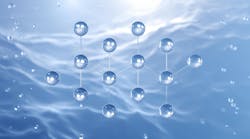NSF/ANSI Standard 61: Drinking Water System Components - Health Effects now allows additional types of stainless steel as acceptable materials for use in the manufacturing of drinking water equipment.
“The incorporation of these stainless steel grades allows drinking water treatment and distribution equipment manufacturers greater latitude in selecting stainless materials for products that are certified to NSF/ANSI Standard 61,” said Dave Purkiss, general manager of NSF’s Drinking Water Treatment and Distribution Systems Program. According to Purkiss, the incorporation of these additional grades into the standard will save equipment manufacturers time and expense in getting their products certified to NSF 61 while continuing NSF’s ongoing commitment to protecting the public.
NSF/ANSI Standard 61 is the American National Standard that ensures pipes, tubes, storage tanks and other products that come in contact with drinking water do not contribute levels of contaminants that could cause serious health problems. Forty-five U.S. states and two Canadian provinces require drinking water system components to comply with NSF/ANSI Standard 61 requirements.
The NSF/ANSI Standard verifies that stainless steels are highly resistant to leaching of contaminates into potable water. Duplex stainless steel grades 2205, 2304, 2101 and 2003 have been incorporated into the standard. These are in addition to types 304, 304L, 316 and 316L, which had previously been accepted under NSF/ANSI Standard 61.
To verify the acceptability of stainless steel, NSF tested randomly selected samples from stainless steel manufacturers. The samples underwent an aggressive three-week exposure period according to the requirements of NSF/ANSI Standard 61. Collected water samples were analyzed for a wide range of contaminants including lead, arsenic and chromium.
The modification of the standard was approved by the NSF Joint Committee on Drinking Water Additives, which oversees NSF/ANSI Standard 61, and the NSF Council of Public Health Consultants, an independent advisory group of professional and regulatory officials, which reviews all NSF standards to ensure they provide public health protection. The additional section can be found in Annex C of NSF/ANSI Standard 61: 2005.
“The stainless steel industry has responded to the requirements of the water product manufacturers who needed a larger selection of stainless steel grades that were acceptable under NSF 61. This allows the industry a greater selection of materials that can be used in NSF 61-certified products without further testing,” said John Grocki, treasurer of Stop Pipe Leaks, Ask for Stainless Help (SPLASH), Inc.
Source: NSF

